-
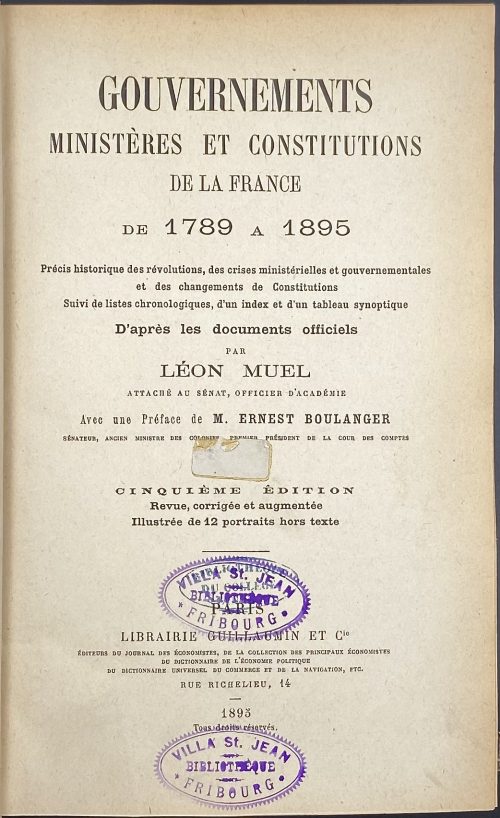 Title-page: GOUVERNEMENTS | MINISTÈRES ET CONSTITUTIONS | DE LA FRANCE | DE 1789 A 1895 | Précis historique des révolutions, des crises ministérielles et gouvernementales | et des changements de Constitutions | Suivi de listes chronologiques, d’un index et d’un tableau synoptique | D’après les documents officiels | PAR | LÉON MUEL | ATTACHÉ AU SÉNAT, OFFICIER D’ACADÉMIE | Avec une Préface de M. ERNEST BOULANGER | SÉNATEUR, ANCIEN MINISTRE DES COLONIES, PREMIER PRÉSIDENT DE LA COUR DES COMPTES | CINQUIÈME ÉDITION | Revue, corrigée et augmentée | Illustrée de 12 portraits hors texte | — | PARIS | LIBRAIRIE GUILLAUMIN ET Cie | ÉDITEURS DU JOURNAL DES ÉCONOMISTES, DE LA COLLECTION DES PRINCIPAUX ÉCONOMISTES | DU DICTIONNAIRE DE L’ÉCONOMIE POLITIQUE | DU DICTIONNAIRE UNIVERSEL DU COMMERCE ET DE LA NAVIGATION, ETC. | RUE RICHELIEU, 14 | 1895 | Tous droits réservés. || Binding: Hardcover, 22.1 x 16.6 cm x 5.0 cm, 8vo, quarter brown morocco over marbled boards, raised bands with gilt fillets and black label with gilt lettering to spine, marbled endpapers. Library stamps to t.p. and inside in blue ink: “VILLA St. JEAN | BIBLIOTHÈQUE | * FRIBOURG *”. Villa St. Jean International School, originally named Collège Villa St. Jean, was a private Catholic school in Fribourg, Switzerland, from 1903 to 1970 (see Wikipedia). Collation: ffl, π4, [1] 2-348, χ6, Suppl.: [1] 2-98, χ2, ffl; total within the flyleaves 282+76 leaves, some uncut; plus twelve plates (photographs) with tissue guards and two folding tables. Pagination: [i-v] vi-x, [2] [1] 2-4, (lacks 4: 5-8) [9] 10-535 [536] (lacks 2: 537, 538) [539] 540-557 [558 blank]; Supplément [1] 2-144, [145-6 table alphabét./blank], [147-8 table des matières/blank]; total within the flyleaves 564+148 pages, ils., plates. Provenance: Library of Villa St. Jean, Fribourg, Switzerland. Contributors: Muel, Léon (French, 1850 – 19..?) – author. Boulanger, Ernest-Théophile (French, 1831 – 1907) – author of preface. Librairie de Guillaumin et Cie – publisher. Table of contents:AVANT-PROPOSLETTRE-PRÉFACEPREMIÈRE PARTIEI. – MONARCHIE FRANÇAISE – BOURBONSLouis XVI, roi de France et de Navarre (10 MAI 1774 – 21 SEPTEMBRE 1792)II. – RÉPUBLIQUE FRANÇAISE (21 SEPTEMBRE 1792 – 18 MAI 1804)Convention nationale (20 SEPTEMBRE 1792 – 26 OCTOBRE 1795)Directoire exécutif (2 NOVEMBRE 1795 – 10 NOVEMBRE 1799)Consulat (19 BRUMAIRE AN VIII – 28 FLORÉAL AN XII) (10 NOVEMBRE 1799-18 MAI 1804);III. – EMPIRE FRANÇAIS (18 MAI 1804 – 31 MARS 1814)Napoléon Ier, Empereur des Français (18 MAI 1804 – 31 MARS 1814)Gouvernement provisoire (1er 14 AVRIL 1814)IV. – RESTAURATION – BOURBONS (14 AVRIL 1814 – 29 JUILLET 1830)Lieutenance générale du Royaume (14 AVRIL – 2 MAI 1814)Louis XVIII, roi de France et de Navarre (2 MAI 1814 – 20 MARS 1815)Cent Jours (20 MARS – 22 JUIN 1815)Commission de Gouvernement (22 JUIN – 7 JUILLET 1815)Louis XVIII, roi de France et de Navarre (8 JUILLET 1815 – 16 SEPTEMBRE 1824)Charles X, roi de France et de Navarre (16 SEPTEMBRE 1824 – 29 JUILLET 1830)Révolution de 1830Chute de Charles X et du ministère Polignac (29 JUILLET 1830). Gouvernement provisoire (29 – 31 JUILLET 1830)V. – MONARCHIE CONSTITUTIONNELLE – BRANCHE D'ORLÉANS (31 JUILLET 1830 – 24 FÉVRIER 1848)Lieutenance générale du Royaume (31 JUILLET – 9 AOUT 1830)Louis-Philippe Ier, roi des Français (9 AOUT 1830 – 24 FÉVRIER 1848)Révolution de 1848Chute du ministère Guizot (23 février) et du roi Louis-Philippe (24 février 1848)VI. – DEUXIÈME RÉPUBLIQUE FRANÇAISE (24 FÉVRIER 1848 – 2 DÉCEMBRE 1852)Gouvernement provisoire (24 FÉVRIER – 9 MAI 1848)Assemblée Nationale Constituante (4 MAI 1848 – 26 MAI 1849)Commission exécutive (9 MAI – 24 JUIN 1848)Le général Cavaignac chef du Pouvoir exécutif Président du Conseil des Ministres (28 JUIN – 20 DÉCEMBRE 1848)Louis-Napoléon Bonaparte Président de la République Française (20 DÉCEMBRE 1848 – 2 DÉCEMBRE 1852)VII. – SECOND EMPIRE FRANÇAIS (2 DÉCEMBRE 1852 – 4 SEPTEMBRE 1870)Napoléon III, empereur des Français (2 DÉCEMBRE 1852 – 4 SEPTEMBRE 1870)Révolution du 4 septembre 1870 Chute du second Empire et du ministère PalikaoVIII. – TROISIÈME RÉPUBLIQUE FRANÇAISE (4 SEPTEMBRE 1870)Gouvernement de la Défense nationale (4 SEPTEMBRE 1870 – 17 FÉVRIER 1871)Assemblée Nationale Constituante (13 FÉVRIER 1871 – 8 MARS 1876)M. Thiers Chef du Pouvoir exécutif (17 FÉVRIER – 31 AOUT 1871)M. Thiers Président de la République Française (31 AOUT 1871 – 24 MAI 1873)M. le Maréchal de Mac-Mahon, duc de Magenta Président de la République Française (24 MAI 1873 – 30 JANVIER 1879)M. Jules Grévy Président de la République Française (30 JANVIER 1879 – 2 DÉCEMBRE 1887)M. Carnot Président de la République française (3 DÉCEMBRE 1887 – 25 JUIN 1894)SECONDE PARTIE.Listes chronologiques, par ministère, de tous les ministres, depuis le 5 mai 1789 jusqu'en 1890
Title-page: GOUVERNEMENTS | MINISTÈRES ET CONSTITUTIONS | DE LA FRANCE | DE 1789 A 1895 | Précis historique des révolutions, des crises ministérielles et gouvernementales | et des changements de Constitutions | Suivi de listes chronologiques, d’un index et d’un tableau synoptique | D’après les documents officiels | PAR | LÉON MUEL | ATTACHÉ AU SÉNAT, OFFICIER D’ACADÉMIE | Avec une Préface de M. ERNEST BOULANGER | SÉNATEUR, ANCIEN MINISTRE DES COLONIES, PREMIER PRÉSIDENT DE LA COUR DES COMPTES | CINQUIÈME ÉDITION | Revue, corrigée et augmentée | Illustrée de 12 portraits hors texte | — | PARIS | LIBRAIRIE GUILLAUMIN ET Cie | ÉDITEURS DU JOURNAL DES ÉCONOMISTES, DE LA COLLECTION DES PRINCIPAUX ÉCONOMISTES | DU DICTIONNAIRE DE L’ÉCONOMIE POLITIQUE | DU DICTIONNAIRE UNIVERSEL DU COMMERCE ET DE LA NAVIGATION, ETC. | RUE RICHELIEU, 14 | 1895 | Tous droits réservés. || Binding: Hardcover, 22.1 x 16.6 cm x 5.0 cm, 8vo, quarter brown morocco over marbled boards, raised bands with gilt fillets and black label with gilt lettering to spine, marbled endpapers. Library stamps to t.p. and inside in blue ink: “VILLA St. JEAN | BIBLIOTHÈQUE | * FRIBOURG *”. Villa St. Jean International School, originally named Collège Villa St. Jean, was a private Catholic school in Fribourg, Switzerland, from 1903 to 1970 (see Wikipedia). Collation: ffl, π4, [1] 2-348, χ6, Suppl.: [1] 2-98, χ2, ffl; total within the flyleaves 282+76 leaves, some uncut; plus twelve plates (photographs) with tissue guards and two folding tables. Pagination: [i-v] vi-x, [2] [1] 2-4, (lacks 4: 5-8) [9] 10-535 [536] (lacks 2: 537, 538) [539] 540-557 [558 blank]; Supplément [1] 2-144, [145-6 table alphabét./blank], [147-8 table des matières/blank]; total within the flyleaves 564+148 pages, ils., plates. Provenance: Library of Villa St. Jean, Fribourg, Switzerland. Contributors: Muel, Léon (French, 1850 – 19..?) – author. Boulanger, Ernest-Théophile (French, 1831 – 1907) – author of preface. Librairie de Guillaumin et Cie – publisher. Table of contents:AVANT-PROPOSLETTRE-PRÉFACEPREMIÈRE PARTIEI. – MONARCHIE FRANÇAISE – BOURBONSLouis XVI, roi de France et de Navarre (10 MAI 1774 – 21 SEPTEMBRE 1792)II. – RÉPUBLIQUE FRANÇAISE (21 SEPTEMBRE 1792 – 18 MAI 1804)Convention nationale (20 SEPTEMBRE 1792 – 26 OCTOBRE 1795)Directoire exécutif (2 NOVEMBRE 1795 – 10 NOVEMBRE 1799)Consulat (19 BRUMAIRE AN VIII – 28 FLORÉAL AN XII) (10 NOVEMBRE 1799-18 MAI 1804);III. – EMPIRE FRANÇAIS (18 MAI 1804 – 31 MARS 1814)Napoléon Ier, Empereur des Français (18 MAI 1804 – 31 MARS 1814)Gouvernement provisoire (1er 14 AVRIL 1814)IV. – RESTAURATION – BOURBONS (14 AVRIL 1814 – 29 JUILLET 1830)Lieutenance générale du Royaume (14 AVRIL – 2 MAI 1814)Louis XVIII, roi de France et de Navarre (2 MAI 1814 – 20 MARS 1815)Cent Jours (20 MARS – 22 JUIN 1815)Commission de Gouvernement (22 JUIN – 7 JUILLET 1815)Louis XVIII, roi de France et de Navarre (8 JUILLET 1815 – 16 SEPTEMBRE 1824)Charles X, roi de France et de Navarre (16 SEPTEMBRE 1824 – 29 JUILLET 1830)Révolution de 1830Chute de Charles X et du ministère Polignac (29 JUILLET 1830). Gouvernement provisoire (29 – 31 JUILLET 1830)V. – MONARCHIE CONSTITUTIONNELLE – BRANCHE D'ORLÉANS (31 JUILLET 1830 – 24 FÉVRIER 1848)Lieutenance générale du Royaume (31 JUILLET – 9 AOUT 1830)Louis-Philippe Ier, roi des Français (9 AOUT 1830 – 24 FÉVRIER 1848)Révolution de 1848Chute du ministère Guizot (23 février) et du roi Louis-Philippe (24 février 1848)VI. – DEUXIÈME RÉPUBLIQUE FRANÇAISE (24 FÉVRIER 1848 – 2 DÉCEMBRE 1852)Gouvernement provisoire (24 FÉVRIER – 9 MAI 1848)Assemblée Nationale Constituante (4 MAI 1848 – 26 MAI 1849)Commission exécutive (9 MAI – 24 JUIN 1848)Le général Cavaignac chef du Pouvoir exécutif Président du Conseil des Ministres (28 JUIN – 20 DÉCEMBRE 1848)Louis-Napoléon Bonaparte Président de la République Française (20 DÉCEMBRE 1848 – 2 DÉCEMBRE 1852)VII. – SECOND EMPIRE FRANÇAIS (2 DÉCEMBRE 1852 – 4 SEPTEMBRE 1870)Napoléon III, empereur des Français (2 DÉCEMBRE 1852 – 4 SEPTEMBRE 1870)Révolution du 4 septembre 1870 Chute du second Empire et du ministère PalikaoVIII. – TROISIÈME RÉPUBLIQUE FRANÇAISE (4 SEPTEMBRE 1870)Gouvernement de la Défense nationale (4 SEPTEMBRE 1870 – 17 FÉVRIER 1871)Assemblée Nationale Constituante (13 FÉVRIER 1871 – 8 MARS 1876)M. Thiers Chef du Pouvoir exécutif (17 FÉVRIER – 31 AOUT 1871)M. Thiers Président de la République Française (31 AOUT 1871 – 24 MAI 1873)M. le Maréchal de Mac-Mahon, duc de Magenta Président de la République Française (24 MAI 1873 – 30 JANVIER 1879)M. Jules Grévy Président de la République Française (30 JANVIER 1879 – 2 DÉCEMBRE 1887)M. Carnot Président de la République française (3 DÉCEMBRE 1887 – 25 JUIN 1894)SECONDE PARTIE.Listes chronologiques, par ministère, de tous les ministres, depuis le 5 mai 1789 jusqu'en 1890 -
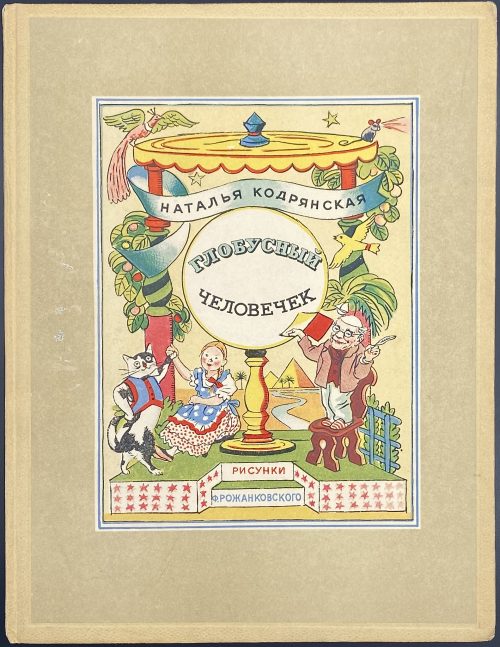 Hardcover volume, 27.8 x 21.4 cm, bound in tan buckram with pictorial paper pasted to front and back boards, brown lettering to spine; pp: fep, [1-6] 7-67 [68] [2] ffl, fep, total 37 leaves; 5 full-page plates, incl. frontispiece (within pagination), covers’ and t.p. vignettes, headpieces, in-text illustrations (eleven in total) chromolithographs after Rojankovsky; the tailpieces are photomechanically reproduced. Title-page (in colour): НАТАЛЬЯ КОДРЯНСКАЯ | ГЛОБУСНЫЙ | ЧЕЛОВЕЧЕК | {vignette} | ИЛЛЮСТРАЦИИ ФЕДОРА РОЖАНКОВСКОГО || Colophon: CET OUVRAGE | A ÉTÉ IMPRIMÉ A PARIS | LA LITHOGRAPHIE | PAR MOURLOT FRÈRES | LA TYPOGRAPHIE | PAR L’IMPRIMERIE UNION | {blank}] | TOUS DROITS RÉSERVÉS POUR PAYS | COPYRIGHT 1954 BY NATALIE CODRAY | Printed in France || Contributors: Наталья Владимировна Кодрянская [Natalie Codray] (Russian-American, 1901 – 1983) – author. Feodor Rojankovsky [Rojan, Фёдор Степанович Рожанковский] (Russian-American, 1891 – 1970) – artist. Mourlot Frères – printer/lithographs. L’imprimerie Union – printer/text.
Hardcover volume, 27.8 x 21.4 cm, bound in tan buckram with pictorial paper pasted to front and back boards, brown lettering to spine; pp: fep, [1-6] 7-67 [68] [2] ffl, fep, total 37 leaves; 5 full-page plates, incl. frontispiece (within pagination), covers’ and t.p. vignettes, headpieces, in-text illustrations (eleven in total) chromolithographs after Rojankovsky; the tailpieces are photomechanically reproduced. Title-page (in colour): НАТАЛЬЯ КОДРЯНСКАЯ | ГЛОБУСНЫЙ | ЧЕЛОВЕЧЕК | {vignette} | ИЛЛЮСТРАЦИИ ФЕДОРА РОЖАНКОВСКОГО || Colophon: CET OUVRAGE | A ÉTÉ IMPRIMÉ A PARIS | LA LITHOGRAPHIE | PAR MOURLOT FRÈRES | LA TYPOGRAPHIE | PAR L’IMPRIMERIE UNION | {blank}] | TOUS DROITS RÉSERVÉS POUR PAYS | COPYRIGHT 1954 BY NATALIE CODRAY | Printed in France || Contributors: Наталья Владимировна Кодрянская [Natalie Codray] (Russian-American, 1901 – 1983) – author. Feodor Rojankovsky [Rojan, Фёдор Степанович Рожанковский] (Russian-American, 1891 – 1970) – artist. Mourlot Frères – printer/lithographs. L’imprimerie Union – printer/text. -
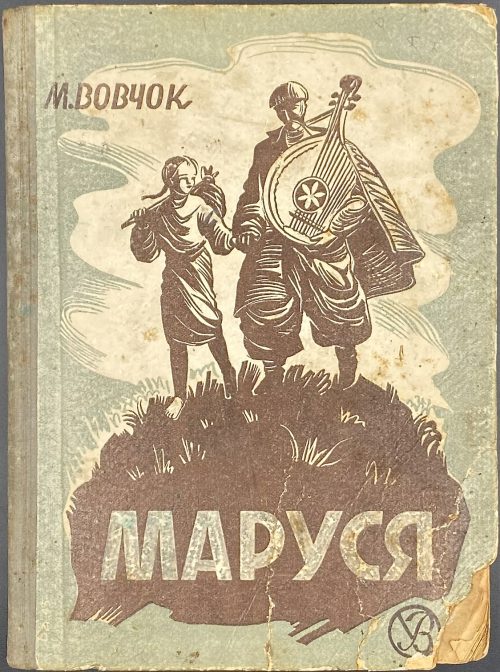 Hardcover, 20.5 x 15.2 cm, pictorial paper over cardboard, cloth-backed; pp.: [1-2] 3-98 [2], last page blank; collated 8vo: 1-58 610; 50 leaves total. Title-page: МАРКО ВОВЧОК | МАРУСЯ | ПОВIСТЬ | УКРАЇНСЬКЕ ВИДАВНИЦТВО | — | КРАКІВ 1943 ЛЬВІВ || Contributors: Марко Вовчок [Marko Vovchok; Марія Олександрівна Вілінська] (Ukrainian, 1833 – 1907) – author. «Українське видавництво» у Кракові-Львові [Verlag: „Ukrainischer Verlag“]– publisher. З друкарні „Поспішної“, Краків, Райхсштрассе 34 [Buchdruck. „Pospieschna“, Krakau, Reichsstrasse 34] – printer. Reichsstrasse (Krakow, Poland) = Ulica Karmelicka (Kraków, Poland). The French version of the Ukrainian name Маруся —> MAROUSSIA. The French version of the book: LIB-2674.2021. Other variants of the author's name Марко Вовчок: Markowovzok and Marko Vovtchok.
Hardcover, 20.5 x 15.2 cm, pictorial paper over cardboard, cloth-backed; pp.: [1-2] 3-98 [2], last page blank; collated 8vo: 1-58 610; 50 leaves total. Title-page: МАРКО ВОВЧОК | МАРУСЯ | ПОВIСТЬ | УКРАЇНСЬКЕ ВИДАВНИЦТВО | — | КРАКІВ 1943 ЛЬВІВ || Contributors: Марко Вовчок [Marko Vovchok; Марія Олександрівна Вілінська] (Ukrainian, 1833 – 1907) – author. «Українське видавництво» у Кракові-Львові [Verlag: „Ukrainischer Verlag“]– publisher. З друкарні „Поспішної“, Краків, Райхсштрассе 34 [Buchdruck. „Pospieschna“, Krakau, Reichsstrasse 34] – printer. Reichsstrasse (Krakow, Poland) = Ulica Karmelicka (Kraków, Poland). The French version of the Ukrainian name Маруся —> MAROUSSIA. The French version of the book: LIB-2674.2021. Other variants of the author's name Марко Вовчок: Markowovzok and Marko Vovtchok. -
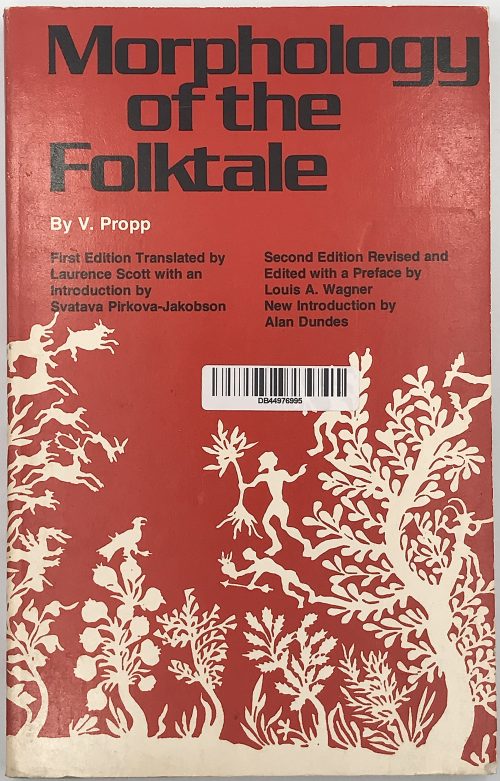 Paperback, 21.5 x 13.6 cm, red and white original wrappers with black lettering, barcode label to front, previous owner’s black ink ms to h.t. Rene Shekerjian; pp.: [i-vii] viii-xxvi[1-3] 4-158 (total 184 pp.). Title-page: Morphology | of the | Folktale | by | V. Propp | First Edition Translated by Lawrence Scott with an Introduction by Svatava Pirkova-Jacobson | Second Edition Revised and Edited with a Preface by Louis A. Warner/New Introduction by Alan Dundes | University of Texas Press • Austin and London || Serial title: American Folklore Society Bibliographical and Special Series | Volume 9/Revised Edition/1968 | [blank] Indiana University Research Center in Anthropology, Folklore, | and Linguistics | Publication 10/Revised Edition/1968 || Edition: 7th paperback printing. Contributors: Владимир Яковлевич Пропп [Vladimir Propp] (Russian, 1895 – 1970) For other editions, see [LIB-1710.2019] В. Я. Пропп. Исторические корни волшебной сказки (2-е изд.) — Л.: Изд-во ЛГУ, 1986; [LIB-3184.2023] В. Я. Пропп. Исторические корни волшебной сказки (1-е изд.) — Л.: Изд-во Ленинградского ун-та, 1946, and [LIB-1718.2019] В. Я. Пропп. Морфология сказки / Серия: Вопросы поэтики, вып. XII. — Л.: Academia, 1928.
Paperback, 21.5 x 13.6 cm, red and white original wrappers with black lettering, barcode label to front, previous owner’s black ink ms to h.t. Rene Shekerjian; pp.: [i-vii] viii-xxvi[1-3] 4-158 (total 184 pp.). Title-page: Morphology | of the | Folktale | by | V. Propp | First Edition Translated by Lawrence Scott with an Introduction by Svatava Pirkova-Jacobson | Second Edition Revised and Edited with a Preface by Louis A. Warner/New Introduction by Alan Dundes | University of Texas Press • Austin and London || Serial title: American Folklore Society Bibliographical and Special Series | Volume 9/Revised Edition/1968 | [blank] Indiana University Research Center in Anthropology, Folklore, | and Linguistics | Publication 10/Revised Edition/1968 || Edition: 7th paperback printing. Contributors: Владимир Яковлевич Пропп [Vladimir Propp] (Russian, 1895 – 1970) For other editions, see [LIB-1710.2019] В. Я. Пропп. Исторические корни волшебной сказки (2-е изд.) — Л.: Изд-во ЛГУ, 1986; [LIB-3184.2023] В. Я. Пропп. Исторические корни волшебной сказки (1-е изд.) — Л.: Изд-во Ленинградского ун-та, 1946, and [LIB-1718.2019] В. Я. Пропп. Морфология сказки / Серия: Вопросы поэтики, вып. XII. — Л.: Academia, 1928. -
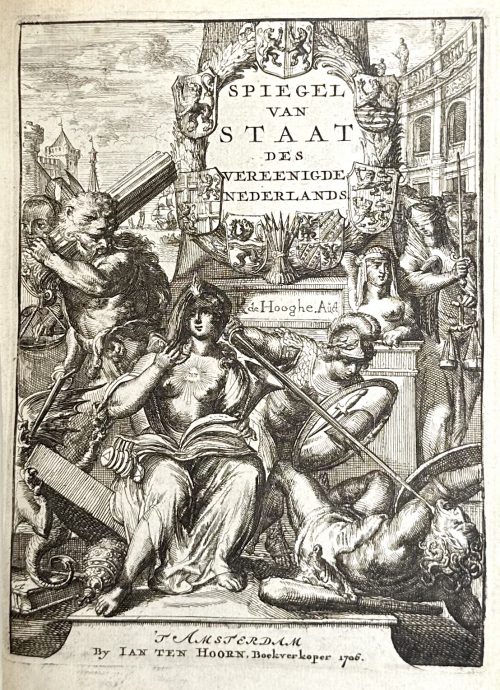 Two hardcover volumes 22.7 x 18.5 x 4.5 cm, uniformly bound in contemporary vellum with a blind border along the edges, handwritten title to spine, printed on laid paper with watermarks to ffls: “Leonard”, “ISRB”, and the arms of Amsterdam. Vol. 1: SPIEGEL van STAAT | des | VEREENIGDE | NEDERLANDS. | Waar in | De Macht en 't Vry Bestier, | Van yder der Zeven Verbonde PROVINCIEN en haar | byzondere Steeden, | Zo in Rechten als Regeeringen werd ontvouwd. | Aanwyzende | Aan, de In, en Uytheemschen, alle de Hooge en Lage Recht- | banken, Collegien en Ampten, dewelke in de zelve, tot | dienst van den Staat, en het Recht, zyn ingesteld. | Hoe, wanneer en waar, voor de zelve yets te verrichten is. | DOOR | Mr: ROMYN de HOOGHE. | EERSTE DEEL: | {fleuron} | t’ AMSTERDAM, | — | By JAN TEN HOORN, Boekverkooper 1706. Collation: 2ffl, *-**4, A-Z4 2A-Z4 3A-O4 4A-G4 5A-S4 6A-F4, 2ffl, (4G2 marked 3G2), total 372 leaves, plus 8 folded leaves of plates, t.p., and half-page vignette dedication by Romeyn de Hooghe. Pagination: [16], 1-267, 268-270 (marked 468-470) 271-480, [2] 3-55 [56], [2] 3-143 [144], [2] 3-44 [4], total 744 pages, ils. Vol. 2: SPIEGEL van STAAT. | VERVATTENDE | DE MACHT DER | GENERALITEYT. | De Edele Mogende Collegiën, | Hooge Rechtbaken, Steden, Schansen | en Onderhoorigheeden, | Welke van Hoog Mogende af angen. | DOOR | Mr: ROMYN de HOOGHE. | TWEEDE DEEL. | Met Figuuren. | {fleuron} | Te AMSTERDAM, | — | By JAN TEN HOORN, | Boekverkooper, 1707. Collation: 2ffl, *-**4, ***2, A-Z4 2A-T4, (A-Z)4, (2A-V)4 X2, 2ffl, total 352 leaves plus 9 folded leaves of plates, t.p., and half-page vignette dedication by Romeyn de Hooghe. Pagination: [20], 1-335 [336], 1-339 [340] [8], total 704 pages, ils. Contributors: Romeyn de Hooghe (Dutch, 1645 – 1708) Jan ten Hoorn (Dutch, fl. 1671 – 1715)
Two hardcover volumes 22.7 x 18.5 x 4.5 cm, uniformly bound in contemporary vellum with a blind border along the edges, handwritten title to spine, printed on laid paper with watermarks to ffls: “Leonard”, “ISRB”, and the arms of Amsterdam. Vol. 1: SPIEGEL van STAAT | des | VEREENIGDE | NEDERLANDS. | Waar in | De Macht en 't Vry Bestier, | Van yder der Zeven Verbonde PROVINCIEN en haar | byzondere Steeden, | Zo in Rechten als Regeeringen werd ontvouwd. | Aanwyzende | Aan, de In, en Uytheemschen, alle de Hooge en Lage Recht- | banken, Collegien en Ampten, dewelke in de zelve, tot | dienst van den Staat, en het Recht, zyn ingesteld. | Hoe, wanneer en waar, voor de zelve yets te verrichten is. | DOOR | Mr: ROMYN de HOOGHE. | EERSTE DEEL: | {fleuron} | t’ AMSTERDAM, | — | By JAN TEN HOORN, Boekverkooper 1706. Collation: 2ffl, *-**4, A-Z4 2A-Z4 3A-O4 4A-G4 5A-S4 6A-F4, 2ffl, (4G2 marked 3G2), total 372 leaves, plus 8 folded leaves of plates, t.p., and half-page vignette dedication by Romeyn de Hooghe. Pagination: [16], 1-267, 268-270 (marked 468-470) 271-480, [2] 3-55 [56], [2] 3-143 [144], [2] 3-44 [4], total 744 pages, ils. Vol. 2: SPIEGEL van STAAT. | VERVATTENDE | DE MACHT DER | GENERALITEYT. | De Edele Mogende Collegiën, | Hooge Rechtbaken, Steden, Schansen | en Onderhoorigheeden, | Welke van Hoog Mogende af angen. | DOOR | Mr: ROMYN de HOOGHE. | TWEEDE DEEL. | Met Figuuren. | {fleuron} | Te AMSTERDAM, | — | By JAN TEN HOORN, | Boekverkooper, 1707. Collation: 2ffl, *-**4, ***2, A-Z4 2A-T4, (A-Z)4, (2A-V)4 X2, 2ffl, total 352 leaves plus 9 folded leaves of plates, t.p., and half-page vignette dedication by Romeyn de Hooghe. Pagination: [20], 1-335 [336], 1-339 [340] [8], total 704 pages, ils. Contributors: Romeyn de Hooghe (Dutch, 1645 – 1708) Jan ten Hoorn (Dutch, fl. 1671 – 1715) -
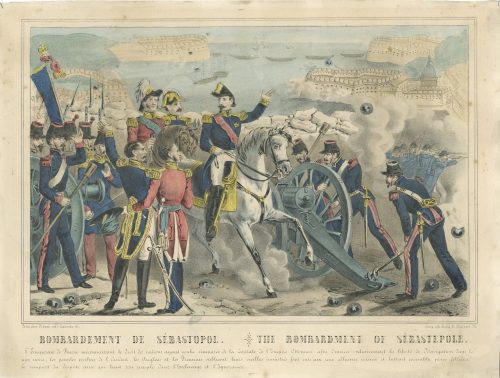 Hand-coloured lithography on wove paper, 250 x 332 mm; black ink stamp “5035” to reverse. Under the frame left: "Paris, chez Riboni, éd. r. Galande, 51"; right: "Paris, lith. Bulla, Pl. Maubert, 26". Below: "BOMBARDEMENT DE SEBASTOPOL. — THE BOMBARDMENT OF SÉBASTOPOLE". Text to bottom. Printers/publishers: Antoine Bulla (fl. 1815 – 1877), François Bulla (fl. c. 1814 – 1855).
Hand-coloured lithography on wove paper, 250 x 332 mm; black ink stamp “5035” to reverse. Under the frame left: "Paris, chez Riboni, éd. r. Galande, 51"; right: "Paris, lith. Bulla, Pl. Maubert, 26". Below: "BOMBARDEMENT DE SEBASTOPOL. — THE BOMBARDMENT OF SÉBASTOPOLE". Text to bottom. Printers/publishers: Antoine Bulla (fl. 1815 – 1877), François Bulla (fl. c. 1814 – 1855). -
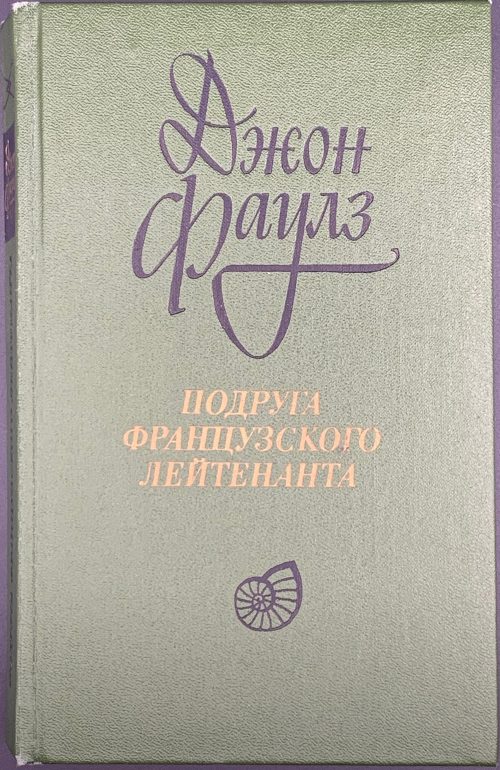 Hardcover, 20.8 x 13.2 cm; publisher's original green cloth with black and gilt lettering to front and spine; pictorial endpapers. Gift ms inscription from Irina Komarova to Yury and Elvina Varshavsky to front free endpaper's verso: "Прослышав, что теперь для Юры / Нет ничего милей гравюры, / Литературу я отныне / Дарю из принципа Эльвине! / И. / Февраль 86". Pp.: [2] 3-477 [3], collation 16mo: 1-1516 (total 240 leaves) plus portrait frontispiece. Title-page: Джон Фаулз | ПОДРУГА | ФРАНЦУЗСКОГО | ЛЕЙТЕНАНТА | РОМАН | Перевод с английского | М. Беккер и И. Комаровой | под редакцией Н. Рахмановой | {vignette} | {publisher’s device} | ЛЕНИНГРАД | «ХУДОЖЕСТВЕННАЯ ЛИТЕРАТУРА» | ЛЕНИНГРАДСКОЕ ОТДЕЛЕНИЕ• 1985 || T.p. verso: […] | JOHN FOWLES | THE FRENCH LIEUTENANT'S WOMAN | Вступительная статья А. ДОЛИНИНА | Примечания М. БЕККЕР | Оформление художников | Н. ВАСИЛЬЕВА и Э. КАПЕЛЮША | […] || Contributors: Беккер, Мэри Иосифовна (Russian, 1920 – 2010) Комарова, Ирина Бенедиктовна (Russian, b. 1933) Рахманова, Наталия Леонидовна (Russian, b. 1930)
Hardcover, 20.8 x 13.2 cm; publisher's original green cloth with black and gilt lettering to front and spine; pictorial endpapers. Gift ms inscription from Irina Komarova to Yury and Elvina Varshavsky to front free endpaper's verso: "Прослышав, что теперь для Юры / Нет ничего милей гравюры, / Литературу я отныне / Дарю из принципа Эльвине! / И. / Февраль 86". Pp.: [2] 3-477 [3], collation 16mo: 1-1516 (total 240 leaves) plus portrait frontispiece. Title-page: Джон Фаулз | ПОДРУГА | ФРАНЦУЗСКОГО | ЛЕЙТЕНАНТА | РОМАН | Перевод с английского | М. Беккер и И. Комаровой | под редакцией Н. Рахмановой | {vignette} | {publisher’s device} | ЛЕНИНГРАД | «ХУДОЖЕСТВЕННАЯ ЛИТЕРАТУРА» | ЛЕНИНГРАДСКОЕ ОТДЕЛЕНИЕ• 1985 || T.p. verso: […] | JOHN FOWLES | THE FRENCH LIEUTENANT'S WOMAN | Вступительная статья А. ДОЛИНИНА | Примечания М. БЕККЕР | Оформление художников | Н. ВАСИЛЬЕВА и Э. КАПЕЛЮША | […] || Contributors: Беккер, Мэри Иосифовна (Russian, 1920 – 2010) Комарова, Ирина Бенедиктовна (Russian, b. 1933) Рахманова, Наталия Леонидовна (Russian, b. 1930) -
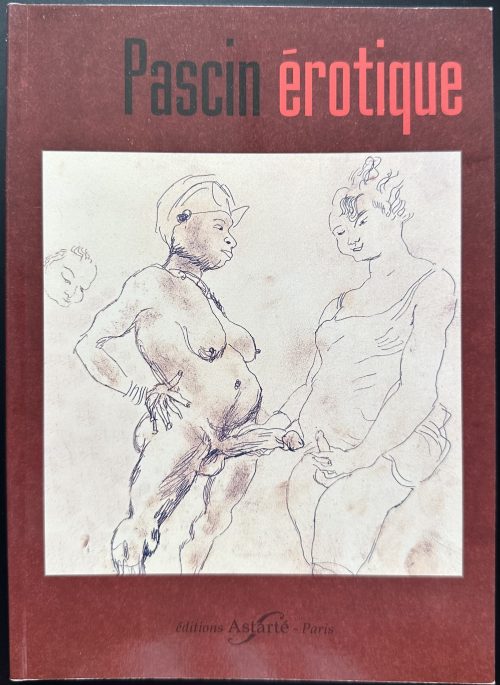 Catalogue raisonné of Pascin's erotic drawings. Softcover, 21 x 15 cm, burgundy gloss pictorial paperback with lettering and vignettes, pp.: [1-3] 4-102 [2], illustrated throughout. Limited edition of 1,000 copies. Title-page: Pascin érotique | {round vignette} | éditions Astarté - Paris || Contributors: Alexandre Dupouy (French) Pascin, Jules [Pincas, Julius Mordecai] (French-Jewish, 1885 – 1930)
Catalogue raisonné of Pascin's erotic drawings. Softcover, 21 x 15 cm, burgundy gloss pictorial paperback with lettering and vignettes, pp.: [1-3] 4-102 [2], illustrated throughout. Limited edition of 1,000 copies. Title-page: Pascin érotique | {round vignette} | éditions Astarté - Paris || Contributors: Alexandre Dupouy (French) Pascin, Jules [Pincas, Julius Mordecai] (French-Jewish, 1885 – 1930) -
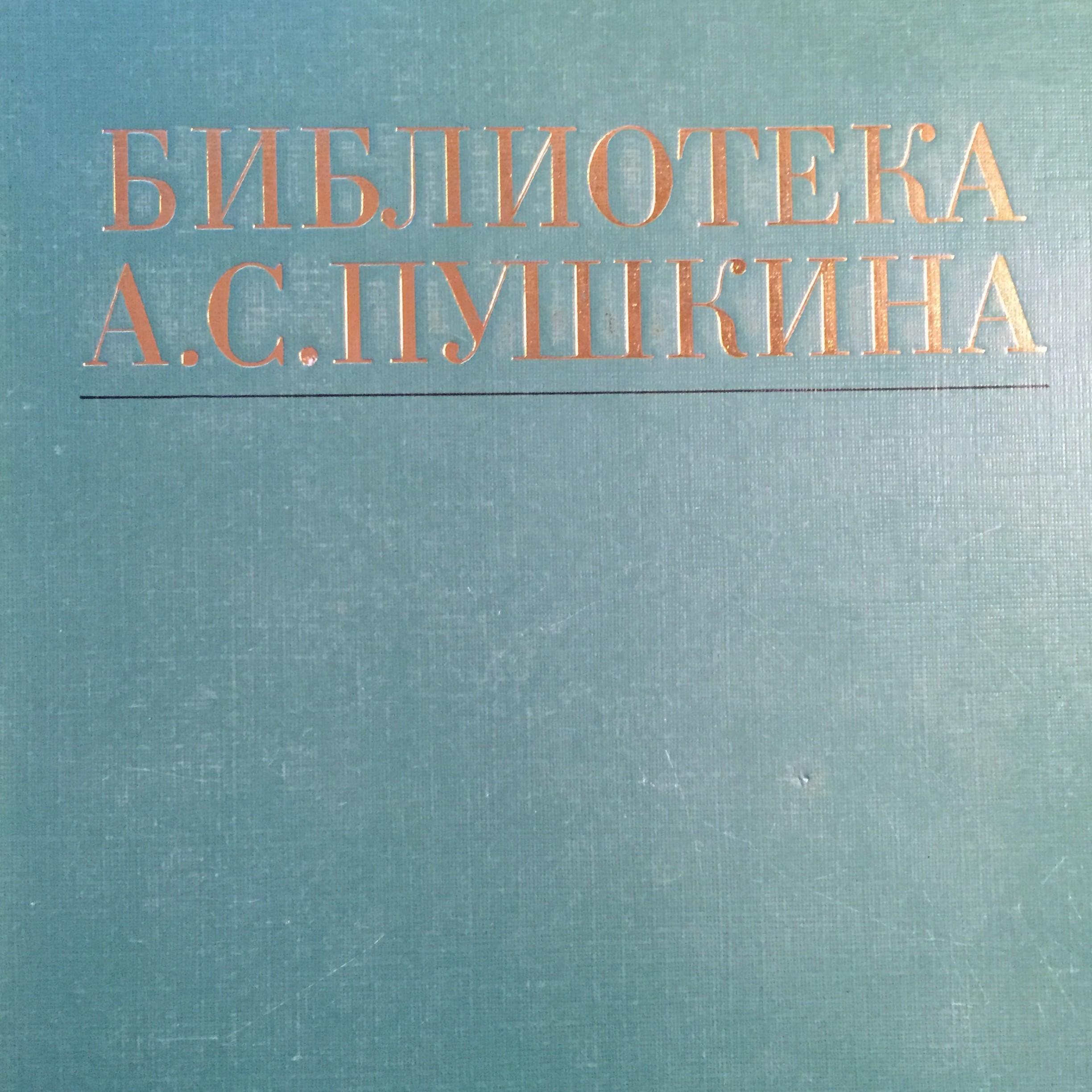
Б. Л. Модзалевский. Библиотека А.С.Пушкина. Библиографическое описание. Отдѣльный оттискъ из изданiя "Пушкинъ и его современники", вып. IX-X. -- СПб.: Тип. Императорской Академiи Наук, 1910. - 442 стр. [РЕПРИНТ 1988 года.]
Библиотека А. С. Пушкина. Б. Л. Модзалевский. Приложение к репринтному изданию. -- М.: Книга, 1988. - 115 стр. Тираж 10 000 экз.
Л. Б. Модзалевский. Библиотека Пушкина. Новые материалы.
Список условных сокращений.
Л. С. Сидяков. Библиотека Пушкина и ее описание.
Примечание к работам Б. Л. и Л. Б. Модзалевских.
-
 Fuchi-kashira of copper, carved and inlaid with gold and shakudō, with the design of Kanzan (on kashira), Chinese: Hanshan, an eccentric poet of the Tang dynasty with a scroll (618-906) who befriended Jittoku (on fuchi, Chinese: Shide, a kitchen helper at a mountain temple, holding a broom). Fuchi is signed Josui (如⽔). Fuchi (Jittoku, holding a broom): 38 x 22 x 12 mm. Weight: 23g (Nakago hole: 27 x 8.5 mm); Kashira (Kanzan, reading a scroll): 34 x 17 x 9 mm. Weight: 10g. Materials: Copper, gold, shakudō. Techniques: Tsuchi-me-ji (hammer-marked surface); usu-shishiai-bori or usuniku-bori (low-relief carving which leaves the image somewhat higher than the surface - high relief effect); zōgan (inlay). Josui was a daughter of Jochiku Kamo (Markus Sesko, Genealogies).
Fuchi-kashira of copper, carved and inlaid with gold and shakudō, with the design of Kanzan (on kashira), Chinese: Hanshan, an eccentric poet of the Tang dynasty with a scroll (618-906) who befriended Jittoku (on fuchi, Chinese: Shide, a kitchen helper at a mountain temple, holding a broom). Fuchi is signed Josui (如⽔). Fuchi (Jittoku, holding a broom): 38 x 22 x 12 mm. Weight: 23g (Nakago hole: 27 x 8.5 mm); Kashira (Kanzan, reading a scroll): 34 x 17 x 9 mm. Weight: 10g. Materials: Copper, gold, shakudō. Techniques: Tsuchi-me-ji (hammer-marked surface); usu-shishiai-bori or usuniku-bori (low-relief carving which leaves the image somewhat higher than the surface - high relief effect); zōgan (inlay). Josui was a daughter of Jochiku Kamo (Markus Sesko, Genealogies). -
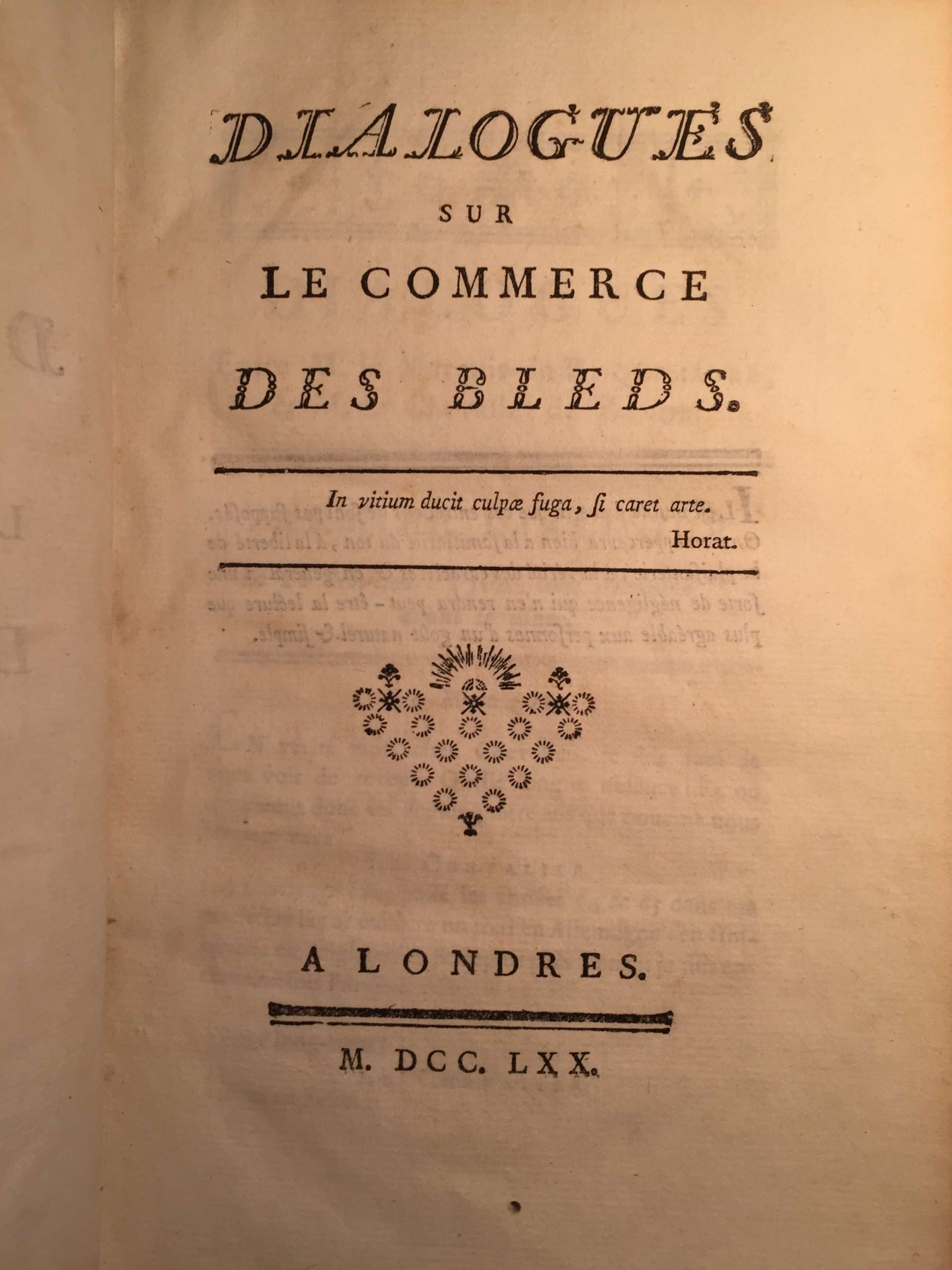
GALIANI, Ferdinando, Abbé. Dialogue sur le commerce des bleds. Londres, 1770. L'Abbé Roubaud, Pierre Joseph André. Récréations économiques ou lettres de l'auteur des représentations aux magistrats, a M. le chevalier Zanobi, principal interlocuteur des Dialogues sur le commerce des bleds; Amsterdam & Paris, Delalain, 1770. Béguillet, Edme. De principiis vegetationis et agreculturae et de causis triplicis culturae in Burgundia disquisitio physica. Auctore E.B.D. ex Societate Œconomica Lugdunensi; Divione, 1768.
-
 Iron tsuba of slightly elongated round form with design of wild geese and drops on pampas grass (masashino) in openwork (sukashi). Rounded rim. Copper sekigane. Owari school. Early Edo period: early 17th century (Kan-ei era). Height: 78.8 mm. Width: 76.3 mm. Rim thickness: 6.1 mm. Center thickness: 6.4 mm. Provenance: Sasano Masayuki Collection, № 169. A description of musashino symbolism can be found at Symbols of Japan by Merrily Baird [Merrily Baird. Symbols of Japan. Thematic motifs in art and design. Rizzoli international publications, Inc., 2001]: Musashino - "the plain of Musashi - a large expanse in the Tokyo area, was celebrated in poetry for the grasses that grew there before the recent era of industrialization... The use of Musashino themes was particularly common in the Momoyama and Edo periods". Pampas grass with dew drops and wild geese in flight collectively provide strong autumnal connotation.
Iron tsuba of slightly elongated round form with design of wild geese and drops on pampas grass (masashino) in openwork (sukashi). Rounded rim. Copper sekigane. Owari school. Early Edo period: early 17th century (Kan-ei era). Height: 78.8 mm. Width: 76.3 mm. Rim thickness: 6.1 mm. Center thickness: 6.4 mm. Provenance: Sasano Masayuki Collection, № 169. A description of musashino symbolism can be found at Symbols of Japan by Merrily Baird [Merrily Baird. Symbols of Japan. Thematic motifs in art and design. Rizzoli international publications, Inc., 2001]: Musashino - "the plain of Musashi - a large expanse in the Tokyo area, was celebrated in poetry for the grasses that grew there before the recent era of industrialization... The use of Musashino themes was particularly common in the Momoyama and Edo periods". Pampas grass with dew drops and wild geese in flight collectively provide strong autumnal connotation. -
 Iron tsuba of round form with two ebi (lobster) on omote (obverse side) and shika (deer) among scattered momiji (maple leaves) on ura (reverse side) motif in brass takabori (high relief) suemon-zōgan. Traces of lacquer. Unsigned. Late Muromachi / Momoyama period (late 16th / Early 17th century). Dimensions: 69.0.6 mm (H) x 69.6 mm (W) x 3.4 mm (T, seppa-dai). Weight: 92.6 g. Illustrated at: The Lundgren Collection of Japanese Swords, Sword Fittings and A Group of Miochin School Metalwork. Christie's Auction: Tuesday, 18 November 1997, London. Sales "GOTO-5881". Christie's, 1997. - #2 at page 7. Provenance: The second John Harding; The Lundgren Collection. Description at Christie's: "The iron plate depicting two lobsters in takabory and brass takazogan, the reverse similarly decorated with deer among scattered maple leaves, square mimi, late Muromachi / early Momoyama period (late 16th/early 17th century) Diameter 68 mm, mimi thickness 4 mm. Provenance: The second John Harding." Also at: JAPANESE SWORD-FITTINGS & METALWORK IN THE LUNDGREN COLLECTION. Published by Otsuka Kogeisha, Tokyo 1992. № 134. Description on page 173: Sword guard with design of shrimps in inlay (scarlet [sic] maple leaves and deer on the reverse side). Unsigned. Heianjō inlay school. Vertical 6.85 cm, horizontal 6.90 cm, Th. of rim 0.40 cm. Iron. Taka-bori relief and brass inlay. Momoyama period, 16th - 17th century. According to Merrily Baird, maple leaves, especially if paired with the deer, allude to autumnal tradition of Japanese aristocracy of viewing the seasonal changes of color in the Nara area. The lobster is typical Japanese ebi, - it lacks prominent claws, and has a spiny shell. As a symbol of longevity and good fortune, lobster is a staple of New Year's decoration.
Iron tsuba of round form with two ebi (lobster) on omote (obverse side) and shika (deer) among scattered momiji (maple leaves) on ura (reverse side) motif in brass takabori (high relief) suemon-zōgan. Traces of lacquer. Unsigned. Late Muromachi / Momoyama period (late 16th / Early 17th century). Dimensions: 69.0.6 mm (H) x 69.6 mm (W) x 3.4 mm (T, seppa-dai). Weight: 92.6 g. Illustrated at: The Lundgren Collection of Japanese Swords, Sword Fittings and A Group of Miochin School Metalwork. Christie's Auction: Tuesday, 18 November 1997, London. Sales "GOTO-5881". Christie's, 1997. - #2 at page 7. Provenance: The second John Harding; The Lundgren Collection. Description at Christie's: "The iron plate depicting two lobsters in takabory and brass takazogan, the reverse similarly decorated with deer among scattered maple leaves, square mimi, late Muromachi / early Momoyama period (late 16th/early 17th century) Diameter 68 mm, mimi thickness 4 mm. Provenance: The second John Harding." Also at: JAPANESE SWORD-FITTINGS & METALWORK IN THE LUNDGREN COLLECTION. Published by Otsuka Kogeisha, Tokyo 1992. № 134. Description on page 173: Sword guard with design of shrimps in inlay (scarlet [sic] maple leaves and deer on the reverse side). Unsigned. Heianjō inlay school. Vertical 6.85 cm, horizontal 6.90 cm, Th. of rim 0.40 cm. Iron. Taka-bori relief and brass inlay. Momoyama period, 16th - 17th century. According to Merrily Baird, maple leaves, especially if paired with the deer, allude to autumnal tradition of Japanese aristocracy of viewing the seasonal changes of color in the Nara area. The lobster is typical Japanese ebi, - it lacks prominent claws, and has a spiny shell. As a symbol of longevity and good fortune, lobster is a staple of New Year's decoration. -

-
 Katsukawa Shun'ei. Signed: Shun'ei ga (春英画). Vertical Ōban. No reference whatsoever. Unidentified play, actors, roles, year, theatre. SOLD
Katsukawa Shun'ei. Signed: Shun'ei ga (春英画). Vertical Ōban. No reference whatsoever. Unidentified play, actors, roles, year, theatre. SOLD -
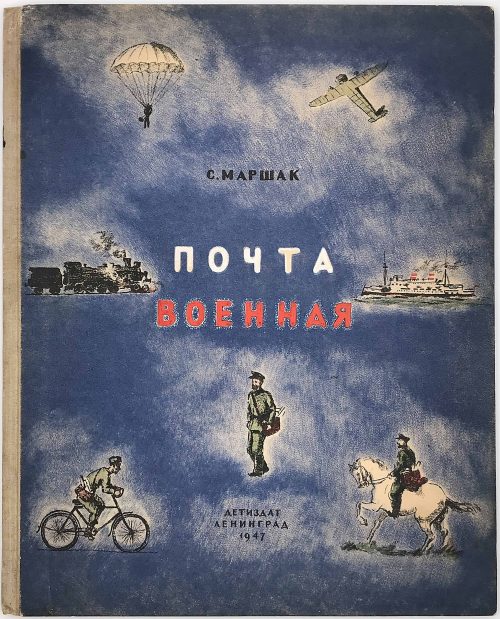 С. Маршак. Почта военная. Детиздат : Ленинград, 1947.
С. Маршак. Почта военная. Детиздат : Ленинград, 1947.Hard-bound Quatro (304 x 246 mm) printed in lithography with hand-colored details on cover.
The name of artist hardly legible on a stamp on frontispiece: скворцов.
The text repeats itself on multiple pages. Most probably the book is a pilot run, never went to mass printing and distribution. -
 Iron tsuba of six-lobed (mutsu-mokkō-gata) form, with six wild boar's eye shape (inome) openings (sukashi). Ryo-Hitsu and the entire perimeter of tsuba have typical for this school raised rim; raised seppa dai. Lobes are decorated in low relief carving (sukidashi-bori). On the obverse: chrysanthemum, Genji mon, waves and rocks, grasses and star, bellflower, star and flower in tortoiseshell (kikko). On the reverse: Stars and different flowers, and flying geese. The plate is damaged to the left of nakago-ana and around the left hitsu-ana. Kamakura-bori school. Late Muromachi period (1514-1573). Diameter: 89 mm; Thickness at seppa-dai: 4.0 mm; Weight: 108.8 g [large]. There is a similar tsuba in this collection, TSU-0345.2018, but with a different motif and much smaller: diameter 74.3 mm, thickness at seppa-dai: 3.2 mm, weight: 62.8 g.Another look-a-like tsuba can be found at the Compton Collection, part II, pp. 14-15, №17, though his tsuba is more massive (80 x 84 x 4 mm).
Iron tsuba of six-lobed (mutsu-mokkō-gata) form, with six wild boar's eye shape (inome) openings (sukashi). Ryo-Hitsu and the entire perimeter of tsuba have typical for this school raised rim; raised seppa dai. Lobes are decorated in low relief carving (sukidashi-bori). On the obverse: chrysanthemum, Genji mon, waves and rocks, grasses and star, bellflower, star and flower in tortoiseshell (kikko). On the reverse: Stars and different flowers, and flying geese. The plate is damaged to the left of nakago-ana and around the left hitsu-ana. Kamakura-bori school. Late Muromachi period (1514-1573). Diameter: 89 mm; Thickness at seppa-dai: 4.0 mm; Weight: 108.8 g [large]. There is a similar tsuba in this collection, TSU-0345.2018, but with a different motif and much smaller: diameter 74.3 mm, thickness at seppa-dai: 3.2 mm, weight: 62.8 g.Another look-a-like tsuba can be found at the Compton Collection, part II, pp. 14-15, №17, though his tsuba is more massive (80 x 84 x 4 mm).
Varshavsky Collection: TSU-0345.2018
This tsuba, TSU-0401.2019, is the biggest of all three (another mine and the one from Campton Collection). The presence of a flower in a tortoiseshell symbol (crest or mon) on this tsuba alludes to Izumo Shrine. The overall piece, with symbols of grasses, waves, flowers, incense, stars, and flying geese, is full of autumnal connotations.
Compton Collection, part II, pp. 14-15, №17: Kamakura-bori tsuba, ca. 1450.
-
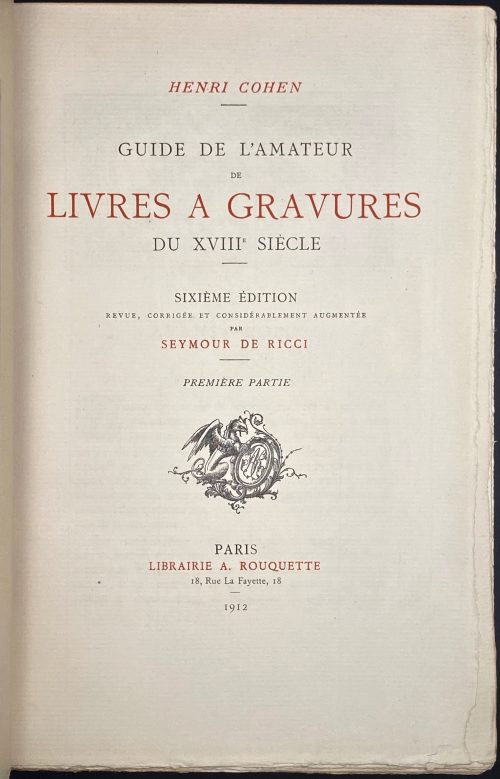 Herni Cohen. Guide de l'amateur de livres à gravures du XVIIIe siècle (6e édition) / Revue, corrigée et considérablement augmentée par Seymour de Ricci, préface par R. Portalis; 2 Volumes. – Paris: Librairie A. Rouquette, 1912. – Achevé d'Imprimer à Melun par Émile Legrand le 25 juin MDCCCCXII [1912]. Vol. 1, Première partie – ABAA-LUY: ffl [4 blanks] [2 - orig. grey front wrapper w/title, verso blank] [2 blanks] [2 - ht, tirage] [2 - blank, frontis. w/protect. sheet] [2 - blank, frontis. w/protect. sheet] (double frontis. - correct), [2 - t.p., blank] [i - avant-propos w/vignette] ii-vi, [vii - préface w/vignette] viii-xxvi; [1-2 - Tome 1, I] 2-668 (two numbers per page), [2 - fin, blank] [2 blanks] [2 - orig. grey back wrapper, recto blank] [orig. spine strip] [4 blanks] bfl. Vol. 2, Seconde partie – MAB-ZUR : ffl [4 blanks] [2 - orig. grey front wrapper w/title, verso blank] [2 blanks] [2 - ht, blank] [2 - t.p., blank] [2 - blank, frontis. w/protect. sheet] [2 - blank, frontis. w/protect. sheet] (double frontis. - correct), [1-2 - Tome II, 22] 671-1248 (two numbers per page), [2 - printer, blank] [2 blanks] [2 - orig. grey back wrapper, recto imprim.] [orig. spine strip] [4 blanks] bfl. Size: Super Royal 8vo, 26.2 x 17.2 x 5.1 cm. Binding: Contemporary blue half morocco over marbled boards, marbled end-papers, top margin gilt, gilt lettering to spine (title, owner: P. R.).; bookplate pasted to verso of the first blank leaf: " Ex Libris R. Decamps Scrive." – for bibliophile René Descamps-Scrive (French, 1853 –1924). Original wrappers preserved. Printed on Hollande paper, copy № 2 of the first 50; total print-run 1050 copies. Catalogue raisonné of French illustrated books of the 18th century.
Herni Cohen. Guide de l'amateur de livres à gravures du XVIIIe siècle (6e édition) / Revue, corrigée et considérablement augmentée par Seymour de Ricci, préface par R. Portalis; 2 Volumes. – Paris: Librairie A. Rouquette, 1912. – Achevé d'Imprimer à Melun par Émile Legrand le 25 juin MDCCCCXII [1912]. Vol. 1, Première partie – ABAA-LUY: ffl [4 blanks] [2 - orig. grey front wrapper w/title, verso blank] [2 blanks] [2 - ht, tirage] [2 - blank, frontis. w/protect. sheet] [2 - blank, frontis. w/protect. sheet] (double frontis. - correct), [2 - t.p., blank] [i - avant-propos w/vignette] ii-vi, [vii - préface w/vignette] viii-xxvi; [1-2 - Tome 1, I] 2-668 (two numbers per page), [2 - fin, blank] [2 blanks] [2 - orig. grey back wrapper, recto blank] [orig. spine strip] [4 blanks] bfl. Vol. 2, Seconde partie – MAB-ZUR : ffl [4 blanks] [2 - orig. grey front wrapper w/title, verso blank] [2 blanks] [2 - ht, blank] [2 - t.p., blank] [2 - blank, frontis. w/protect. sheet] [2 - blank, frontis. w/protect. sheet] (double frontis. - correct), [1-2 - Tome II, 22] 671-1248 (two numbers per page), [2 - printer, blank] [2 blanks] [2 - orig. grey back wrapper, recto imprim.] [orig. spine strip] [4 blanks] bfl. Size: Super Royal 8vo, 26.2 x 17.2 x 5.1 cm. Binding: Contemporary blue half morocco over marbled boards, marbled end-papers, top margin gilt, gilt lettering to spine (title, owner: P. R.).; bookplate pasted to verso of the first blank leaf: " Ex Libris R. Decamps Scrive." – for bibliophile René Descamps-Scrive (French, 1853 –1924). Original wrappers preserved. Printed on Hollande paper, copy № 2 of the first 50; total print-run 1050 copies. Catalogue raisonné of French illustrated books of the 18th century.


